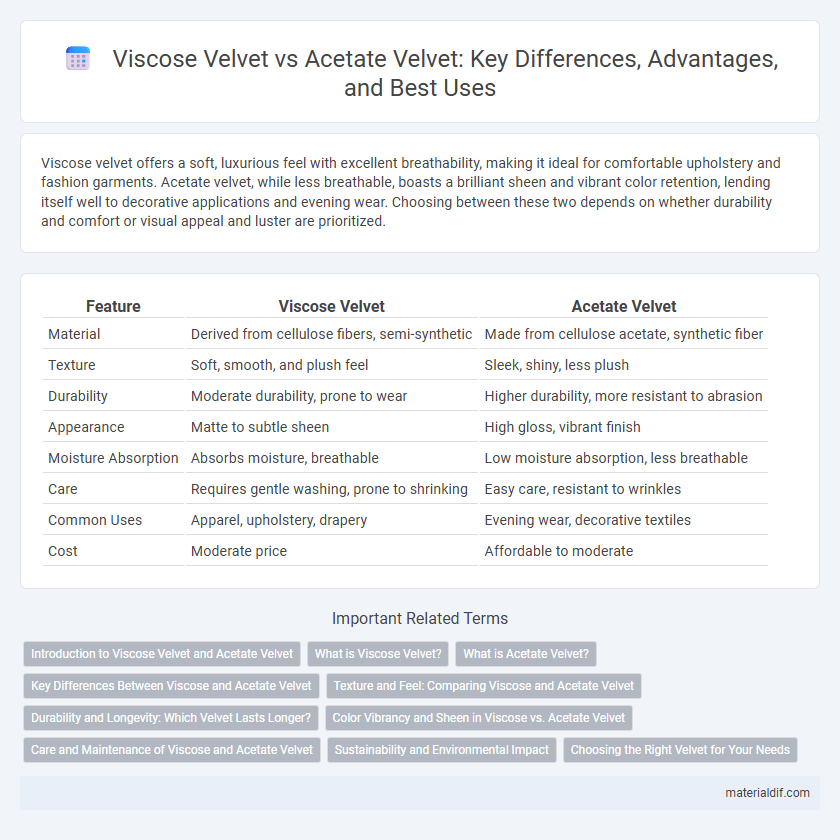Viscose velvet offers a soft, luxurious feel with excellent breathability, making it ideal for comfortable upholstery and fashion garments. Acetate velvet, while less breathable, boasts a brilliant sheen and vibrant color retention, lending itself well to decorative applications and evening wear. Choosing between these two depends on whether durability and comfort or visual appeal and luster are prioritized.
Table of Comparison
| Feature | Viscose Velvet | Acetate Velvet |
|---|---|---|
| Material | Derived from cellulose fibers, semi-synthetic | Made from cellulose acetate, synthetic fiber |
| Texture | Soft, smooth, and plush feel | Sleek, shiny, less plush |
| Durability | Moderate durability, prone to wear | Higher durability, more resistant to abrasion |
| Appearance | Matte to subtle sheen | High gloss, vibrant finish |
| Moisture Absorption | Absorbs moisture, breathable | Low moisture absorption, less breathable |
| Care | Requires gentle washing, prone to shrinking | Easy care, resistant to wrinkles |
| Common Uses | Apparel, upholstery, drapery | Evening wear, decorative textiles |
| Cost | Moderate price | Affordable to moderate |
Introduction to Viscose Velvet and Acetate Velvet
Viscose velvet is a soft, breathable fabric made from regenerated cellulose fibers, prized for its silk-like appearance and luxurious texture. Acetate velvet, produced from acetate fibers derived from wood pulp, offers a lightweight, smooth finish with a subtle sheen but is less durable than viscose velvet. Both fabrics are popular in fashion and upholstery, with viscose velvet favored for its breathability and acetate velvet chosen for its lustrous surface.
What is Viscose Velvet?
Viscose velvet is a luxurious fabric made from regenerated cellulose fibers derived from wood pulp, offering a soft texture and elegant sheen similar to silk. It is highly breathable and absorbent, making it ideal for upholstery, clothing, and drapery where comfort and durability are essential. Unlike acetate velvet, which is less durable and tends to retain static, viscose velvet provides better resilience and moisture-wicking properties.
What is Acetate Velvet?
Acetate velvet is a luxurious fabric made from acetate fibers, known for its smooth texture and brilliant sheen that closely resembles silk. It offers excellent drape and vibrant color retention but is less durable and more prone to damage from heat compared to viscose velvet. This fabric is often used in fashion and upholstery for its elegant appearance, though it requires careful maintenance to preserve its softness and luster.
Key Differences Between Viscose and Acetate Velvet
Viscose velvet is made from regenerated cellulose fibers derived from wood pulp, offering a soft, breathable texture and excellent dye absorption for rich, vibrant colors. In contrast, acetate velvet is synthetic, made from cellulose acetate, providing a glossy finish, greater resistance to moisture, and a more lightweight feel but tends to be less durable. Viscose velvet excels in comfort and aesthetic warmth, while acetate velvet is favored for its sheen and resistance to wrinkles and shrinkage.
Texture and Feel: Comparing Viscose and Acetate Velvet
Viscose velvet offers a soft, smooth texture with a natural sheen that mimics silk, giving it a luxurious and breathable feel ideal for upholstery and apparel. Acetate velvet features a slightly stiffer hand and a more pronounced shine, resulting in a glossy, dramatic appearance but less moisture absorbency and breathability compared to viscose. The tactile difference lies in viscose's plush, supple surface versus acetate's crisp, sleek finish, influencing their suitability for different textile applications.
Durability and Longevity: Which Velvet Lasts Longer?
Viscose velvet exhibits higher durability and longevity compared to acetate velvet due to its stronger fiber structure and better resistance to wear and tear. Viscose fibers maintain their texture and color over time, making viscose velvet a preferred choice for upholstery and heavy-use applications. Acetate velvet tends to degrade faster with prolonged exposure to sunlight and friction, resulting in a shorter lifespan.
Color Vibrancy and Sheen in Viscose vs. Acetate Velvet
Viscose velvet exhibits superior color vibrancy due to its cellulose fiber base, allowing it to absorb dyes more deeply for richer, more intense hues compared to acetate velvet. The sheen of viscose velvet is typically softer and more natural-looking, enhancing its luxurious appearance, while acetate velvet tends to have a shinier, more reflective surface that can sometimes appear synthetic. These characteristics make viscose velvet the preferred choice for applications where depth of color and a subtle, elegant sheen are desired.
Care and Maintenance of Viscose and Acetate Velvet
Viscose velvet requires gentle care due to its moisture sensitivity, including dry cleaning and avoiding direct sunlight to prevent fading and fiber weakening. Acetate velvet demands even more cautious maintenance, as it is prone to melting under high heat and requires low-temperature ironing or professional cleaning. Both fabrics benefit from spot cleaning with a mild detergent and prompt stain treatment to maintain their plush texture and vibrant appearance.
Sustainability and Environmental Impact
Viscose velvet, derived from cellulose fibers obtained from wood pulp, offers greater sustainability due to its biodegradability and potential for renewable sourcing, whereas acetate velvet is synthesized from cellulose acetate, involving more chemical processing and resulting in lower environmental friendliness. The production of viscose typically consumes significant water and energy but has improved with modern eco-friendly technologies, while acetate's manufacturing releases more harmful emissions and is less recyclable. Choosing viscose velvet minimizes ecological footprint through renewable raw materials and better end-of-life disposal options compared to acetate velvet's synthetic and chemically intensive lifecycle.
Choosing the Right Velvet for Your Needs
Viscose velvet offers a soft, breathable texture with excellent drape, ideal for upholstery and luxury apparel requiring durability and comfort. Acetate velvet provides a glossy finish and vibrant color retention, making it suitable for decorative purposes and costumes where visual appeal is prioritized over longevity. Selecting the right velvet depends on balancing the need for durability, appearance, and application environment to ensure the fabric meets specific project requirements.
Viscose Velvet vs Acetate Velvet Infographic

 materialdif.com
materialdif.com